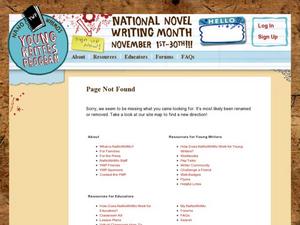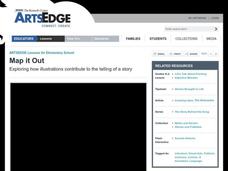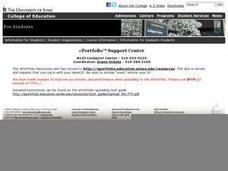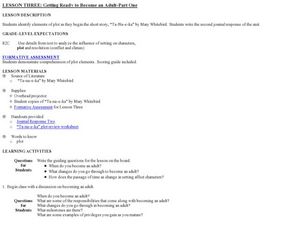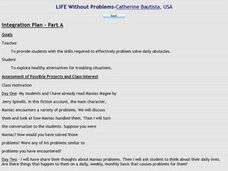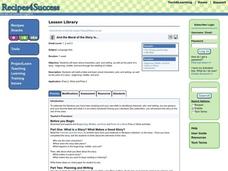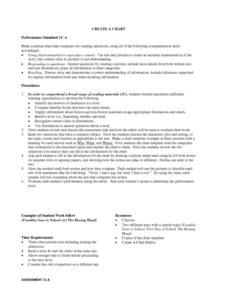Curated OER
Story Stew -- Teaching Character, Plot, And Setting
Students examine the story elements of characters, plot, and setting. They identify the story elements from various "ingredients" taken out of a pot, and add their own story element "ingredients" on index cards into the pot.
Curated OER
Comprehension: Setting
Young scholars discuss what setting represents. In this language arts lesson plan, students review the three elements of setting: where the story takes place, when does the story take place, and is it past, present, or future? Young...
Curated OER
Lesson Plan 5: Creating a Supporting Character
As a class, young writers learn how to develop a strong supporting character. They think and discuss a good friend they know, they use that friend as a basis for a potential supporting character. They create a supporting character as a...
Curated OER
Map It Out
Explore how illustrations add to a story. Young learners will look at picture books to see how the pictures tell the story. They create illustrations to go with a chosen story, and then flip the activity so they have to write a story to...
Do2Learn
Book Report
Tackle the basics of plot with a straightforward book report form. Learners note down the author and title, setting, characters, and basic plot points in any story or book.
Museum of Disability
Ian’s Walk and Apples for Cheyenne
Help young learners understand friendship and empathy with two reading comprehension lessons. Each lesson focuses on a story about a child with autism, and encourages readers to compare and contrast the characters to each other and to...
SEN Teacher
Literacy Dice
Reinforce literacy skills using a six-sided die that focuses on phonics and story starters. Scholars roll, and show what they know about blends, plots, and more!
Teacher's Corner
Dr. Seuss Story Map
Guide young readers through their first book report with a story map designed for a Dr. Seuss book. After your class finishes their story of choice, they list the title, characters, conflict, and other elements of literature on the book...
Curated OER
Robinson Crusoe Island Adventure
After reading and describing the characters, setting, and plot in The Adventures of Robinson Crusoe, class members write original Island Adventure narrative pieces including detailed descriptions of people, places, and things. Afterward,...
Roald Dahl
Fantastic Mr. Fox
A fancifully illustrated guide to Roald Dahl's Fantastic Mr. Fox, this series of lessons, activities, and tasks could be used in its entirety or picked apart and used piecemeal. Have young readers investigate the role of dialogue in...
Curated OER
Lemony Snicket Series Comes to an End (Unfortunately)
An informational text about Lemony Snicket leads to a discussion of the books class members have read in the Series of Unfortunate Events series. Children then compare and contrast the settings, plots, and characters in the...
Curated OER
Introduce Vocabulary: Clap Your Hands
Read Clap Your Hands to explore new vocabulary with your class. In this three-tiered vocabulary instructional activity, youngsters read the book and identify the plot, setting, and characters. They also define vocabulary terms from...
Curated OER
Dr. Seuss Book Report
In this literature response worksheet, students choose a Dr. Seuss book to report on. Students discuss the setting, plot, characters, and then summarize the book.
Mary Pope Osborne, Classroom Adventures Program
The Backpack Travel Journals
Strap on those backpacks, it's time to travel through history with this literature unit based on the first four books of The Magic Tree House series. While reading through these fun stories, children create story maps, record...
Curated OER
Sam and the Lucky Money
Third graders read the story "Sam and the Lucky Money". Individually, they identify new key terms from the story. In groups, they examine the setting and discuss how it relates to the plots and characters. To end the lesson, they read...
Curated OER
Introduction to Little House Books
Third graders identify the main characters in the Ingalls family and describe the relationships between the characters. They locate the setting of the book on a map of the Upper Mid- West. Students understand that the books are set in...
Curated OER
Getting Ready to Become an Adult - Part One
Students read the book Ta-Na-e-ka and identify the elements of plot in the story. In this plot lesson plan, students also create a journal response to the story.
Curated OER
Nursery Rhymes
Students recall details of nursery rhyme read by teacher, identify main characters, and demonstrate knowledge of poem by creating concept map about story that includes title, clip art, and changes in font and color.
Curated OER
Maniac Magee: Life Without Problems
Young readers discuss how they would deal with problems faced by the main character in Maniac Magee. They write down their own problems and exchange them with others to analyze and provide possible solutions. They establish a "Dear Abby"...
Curated OER
And the Moral of the Story is...
Learners discover the parts of a story through the retelling of a fable as well as characters, plot, and setting. This activity is completed using the program Pixie to create an online storybook.
Curated OER
Egg Carton Stories
Students create stories with better structure when they are able to focus on its characters, setting, and plot. Teacher creates settings, character, and problem cartons with information written on strips of paper.
Curated OER
Create a Chart
Students create charts for story elements. They read two selections that share a common theme and discuss the story elements. They create a chart for the characters, plot, and setting and complete it while reading the selections.
Nazareth College
Creative Writing
Students discuss creative writing—what makes something creative writing? Each learner starts writing a story and after 15 minutes, they pass their story to another who adds to it. After another 15 minutes of writing, the story is passed...
Curated OER
Parts of a Story
Learners read a short fiction book and demostrate comprehension by identifying the main characters, setting, conflict, theme, and summarizing the main points. They organize the information in Inspiration and create a powerpoint to show...


